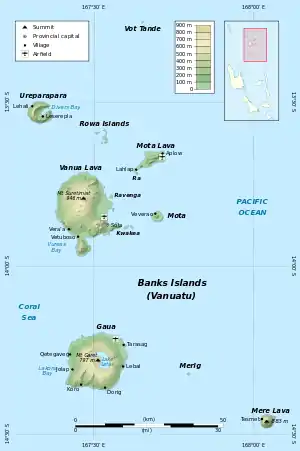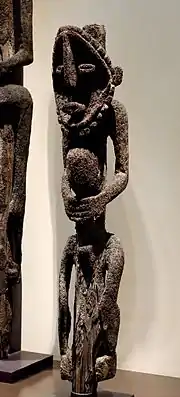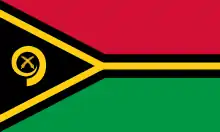Banks Islands
The Banks Islands (in Bislama Bankis) are a group of islands in northern Vanuatu. Together with the Torres Islands to the northwest, they make up the northernmost province of Torba. The group lies about 40 km (25 mi) north of Maewo, and includes Gaua and Vanua Lava, two of the 13 largest islands in Vanuatu. In 2009, the islands supported a population of 8,533[1] on a land area of 780 km².

Geography
The largest island is Gaua (formerly called Santa Maria), which has a rugged terrain, rising to Mount Gharat, an active volcano at the centre of the island, at 797 m (2,615 ft). The freshwater Lake Letas in the crater is the largest lake in Vanuatu. The slightly smaller Vanua Lava, is higher at 946 m (3,104 ft); it also has an active volcano at Mount Suretamate (also spelled Süretimiat or Sere'ama, 921 m (3,022 ft)). To its east are two islets, Ravenga and Kwakea (or Qakea). Sola, the provincial capital, is on this island. The third largest island, Ureparapara (also known as Parapara), is an old volcanic cone that has been breached by the sea, forming Divers Bay on its east coast.
To the east of these larger islands lie a number of smaller ones. The furthest north, 50 km (31 mi) northeast of Ureparapara, is Vet Tagde (Vot Tande or Vot Ganai), an extinct volcano that last erupted 3.5 million years ago. The Rowa Islands (or Reef Islands) are a few very small, low islands on a coral atoll. Mota Lava is the largest and highest (411 m) of this eastern chain of islands; off its southern coast, attached by high corals that one can wade through at low tide, is the tiny islet of Ra. Mota, Merig and Merelava complete the southeastern part of the archipelago.
Islands
| Island name | Area (km²) | Population | Capital | Peak | Height (meter) | Municipality | Coordinates |
| Vot Tande | 0.24 | - | - | ... | 76 | Mota Lava | 13°15′33″S 167°38′34″E |
| Ureparapara | 39 | 437 | Ley (Lesereplag) | Mt Towlap | 764 | Ureparapara | 13°32′S 167°20′E |
| Vanua Lava | 330 | 2623 | Sola | Mt Suretamate | 921 | Vanua Lava | 13°48′S 167°28′E |
| Mota | 9.5 | 683 | Veverao | Mt Tawe | 411 | Mota | 13°51′S 167°42′E |
| Mota Lava | 31 | 1451 | Lahlap | Mt Tuntog | 243 | Mota Lava | 13°39′S 167°42′E |
| Ra (Aya) | 0.5 | 189 | Ra | ... | ... | Mota Lava | 13°43′S 167°37′E |
| Mere Lava | 15 | 647 | Tasmate | Mt Teu (Star Peak) | 833 | Mere Lava | 14°27′S 168°4′E |
| Gaua | 330 | 2491 | Jolap | Mt Gharat | 767 | Gaua | 14°15′54″S 167°31′12″E |
| Merig | 0.5 | 12 | Levolvol | ... | 125 | Mere Lava | 14°19′S 167°48′E |
| Rowa (Reef Islands) | 0.1 | - | - | ... | 2 | Mota Lava | 13°37′S 167°31′E |
| Banks Islands | 780 | 8.533 | Sola | Mt Suretamate | 921 | 6 municipalities[2] | 13°55′S 167°34′E |
Economy
The principal economic activity is subsistence agriculture, though copra, coffee and (on Gaua) cacao are grown for export. The sulphur deposits of Mount Suretamate on Vanua Lava were formerly worked by a French company. Tourism is increasingly important, on the islands with easy transport by airplane.
Transport
There are airports on Mota Lava, Vanua Lava and Gaua, which have a few flights a week with Air Vanuatu. Ships come principally for the exports, but will also take passengers.
History
Like the rest of Vanuatu, the Banks Islands were first settled around the 12th century BCE by Austronesian navigators belonging to the Lapita culture. Archaeologists have found ancient obsidian in Motalava, Vanua Lava and Gaua; and Lapita pottery on Motalava.[3][4]
The Banks Islands were the first part of Vanuatu discovered by a European explorer, from the 25 to 29 April 1606 when a Spanish expedition led by the Portuguese explorer Pedro Fernández de Quirós sailed past Merelava and stopped at Gaua, before landing on Espiritu Santo and establishing a short-lived colony there. Merelava was charted as San Marcos, Mota Lava as Lágrimas de San Pedro (St. Peter’s tears), Vanua Lava as Portal de Belén (Stable at Bethlehem), and Gaua as Santa María.[5]
They were later overlooked in 1774 when Captain James Cook explored Vanuatu and believed he saw the whole chain. They were first explored by William Bligh of the British Navy, and named after his patron Sir Joseph Banks. They were charted by Matthew Flinders. Vanua Lava was first explored by the New Zealand Bishop George Augustus Selwyn in 1859.
Languages
| Island | Language | # speakers |
|---|---|---|
| Ureparapara | Lehali | 200 |
| Ureparapara | Löyöp | 240 |
| Motalava | Volow | 1 |
| Motalava | Mwotlap | 2100 |
| Vanua Lava | Lemerig | 2 |
| Vanua Lava | Vera'a | 500 |
| Vanua Lava | Vurës | 2000 |
| Vanua Lava | Mwesen | 10 |
| Mota | Mota | 750 |
| Gaua | Nume | 700 |
| Gaua | Dorig | 300 |
| Gaua | Koro | 250 |
| Gaua | Olrat | 3 |
| Gaua | Lakon | 800 |
| Merelava | Mwerlap | 1100 |
The population of the Banks Islands speak fifteen different languages.[6][7] Several are endangered, being spoken by no more than a few hundred, and sometimes just a handful of last speakers.
All these languages belong to the Oceanic subgroup of the Austronesian family.[8]
Notes
-
"2009 National Census of Population and Housing: Summary Release" (PDF). Vanuatu National Statistics Office. 2009. Retrieved Nov 23, 2010. Cite journal requires
|journal=(help) - Citypopulation: Vanuatu: Verwaltungsgliederung
- Bedford & Spriggs (2008)
- Reepmeyer (2009:86)
- Kelly, Celsus, O.F.M. La Austrialia del Espiritu Santo. The Journal of Fray Martín de Munilla O.F.M. and other documents relating to the Voyage of Pedro Fernández de Quirós to the South Sea (1605-1606) and the Franciscan Missionary Plan (1617-1627) Cambridge, 1966, p.39, 62.
- See François (2012).
- Detailed list and map of the Banks and Torres languages.
- See François (2011).
References
- Bedford, Stuart; Spriggs, Matthew (2008). "Northern Vanuatu as a Pacific Crossroads: The Archaeology of Discovery, Interaction, and the Emergence of the "Ethnographic Present"" (PDF). Asian Perspectives. 47 (1): 95–120. doi:10.1353/asi.2008.0003. ISSN 1535-8283. Retrieved 2019-02-01..
- François, Alexandre (2011), "Social ecology and language history in the northern Vanuatu linkage: A tale of divergence and convergence" (PDF), Journal of Historical Linguistics, 1 (2): 175–246, doi:10.1075/jhl.1.2.03fra, hdl:1885/29283.
- François, Alexandre (2012), "The dynamics of linguistic diversity: Egalitarian multilingualism and power imbalance among northern Vanuatu languages" (PDF), International Journal of the Sociology of Language, 214: 85–110, doi:10.1515/ijsl-2012-0022.
- Reepmeyer, Christian (2009). "The obsidian sources and distribution systems emanating from Gaua and Vanua Lava in the Banks Islands of Vanuatu". Canberra, ACT: Australian National University. Cite journal requires
|journal=(help).

